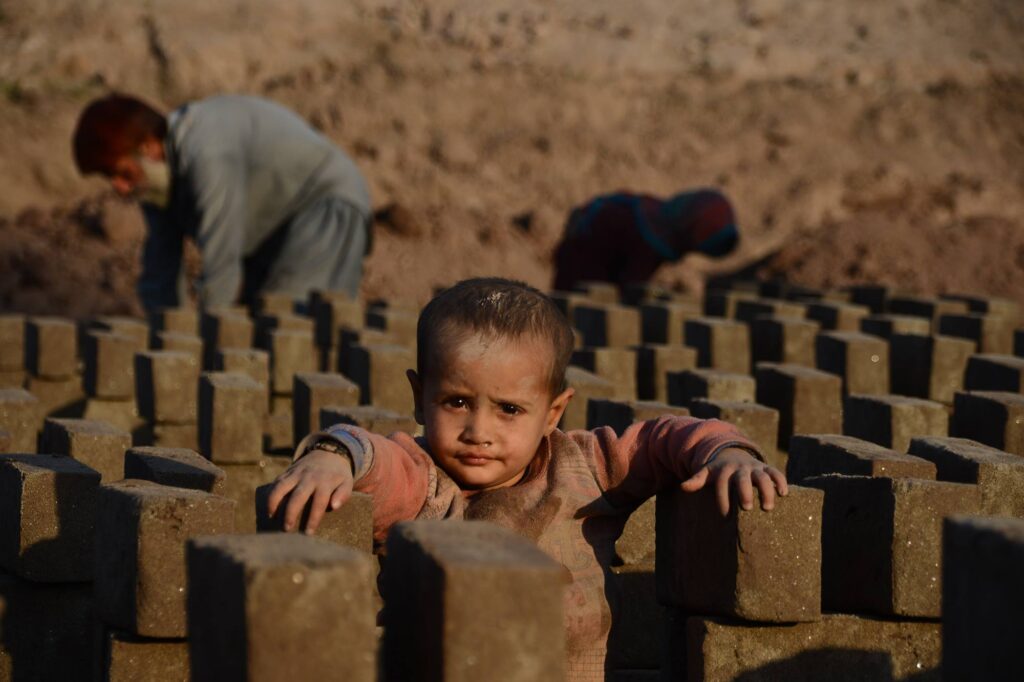Kabul: On a frigid morning in Kabul’s Pashtunistan Square, eight-year-old Hamed stands with a small box of shoe polish and brushes, his hands stained dark from hours of buffing scuffed leather. “We need everything—blankets, shoes, and clothes,” he says, his voice quivering in the cold. Asked to name what he needs most, he summarizes his family’s plight: “It’s winter; we need everything.”
Instead of attending school, Hamed spends his days as a shoeshiner, doing little to help his family survive. He makes roughly 100–150 Afghanis ($1.20–$1.80 USD) daily—just enough to afford some food. His father, incapacitated by diabetes, cannot work, and the responsibility of supporting a family of ten has fallen on Hamed and his younger brother, who also shines shoes. “If my father were healthy,” he says, “I would be in school and could become a doctor.” In a nation teetering on the brink of economic collapse, such dreams are now a distant luxury for many children.
A National Crisis for the Youngest Breadwinners
Hamed’s story is not unique. Across Afghanistan, the burden of poverty weighs heavily on children too young to bear it. In Kandahar, nine-year-old Irfan toils as an apprentice in a car repair workshop. Instead of learning to read and write, he learns to wield wrenches sized for adult hands. “I want to study,” he says quietly, “but I have to work here.” His meager wage of around 200 Afghanis ($2.40 USD) per week helps feed a family of seven.
Working nearby is 11-year-old Inayatullah, who spends his days washing cars rather than pursuing an education. “I am the sole breadwinner for my family,” he says. Once, he dared to dream of becoming a doctor; that ambition has been eroded by unrelenting hardship.

Alarming Statistics and Vanishing Protections
Children like Hamed, Irfan, and Inayatullah form part of a dire statistic: according to the United Nations Office for the Coordination of Humanitarian Affairs (OCHA), 19% of Afghan children are engaged in hard labor. With nearly half of the nation’s population under the age of 15, Afghanistan’s child labor rates are among the highest in the region. The U.S. Department of Labor notes that conditions have deteriorated since the Taliban’s return to power in August 2021, pushing more children into full-time work and forcing education into the background.
Under the previous government, the Law on the Protection of Child Rights strictly prohibited forced labor for anyone under 18, and Article 49 explicitly barred compelling children to work. However, legal safeguards and their enforcement have all but vanished in the current climate. Institutions once charged with protecting children’s welfare are now dysfunctional or nonexistent, leaving families with no recourse but to rely on their youngest members to survive.

Struggling to Balance Work and School
For a fortunate few, the choice between earning and learning remains fluid. Thirteen-year-old Bilal, who sells falafel from a cart on Kabul’s outskirts, manages to attend school part-time. “I work half the day and study the other half,” he says. Yet despite this delicate balance, his family of ten still struggles. Their finances remain precarious despite Bilal’s efforts and his father’s morning shifts.
Others, like ten-year-old Abdul Wali in Kandahar, have no such options. He washes cars from morning until evening, earning about 100 Afghanis ($1.20 USD) a day to feed his family of eight. There are no classrooms in Abdul Wali’s world and no reprieve from an endless cycle of labor.
Lasting Trauma and Stunted Futures
Beyond the immediate loss of education, experts warn of severe long-term consequences for these children. Dr. Faridullah Omari, a child health specialist, cautions that prolonged labor during formative years can lead to chronic illnesses, stunted growth, and enduring mental health issues. “Children who shoulder the burdens of adulthood too early risk long-term trauma,” he says.

A Generation at Stake
Afghanistan’s steep economic decline has cast millions of children into a shadowy underworld of premature responsibility. While a handful struggle to maintain the dream of education, many more find themselves trapped—forced to sacrifice their futures to ensure their families’ survival. As humanitarian conditions worsen and legal protections crumble, an entire generation’s potential is at risk.
For these young Afghan breadwinners, childhood innocence has been replaced by the grim realities of adult life. With few signs of economic recovery and scant international support reaching those in need, the cycle of poverty and child labor persists, dimming the prospects for a brighter tomorrow.






